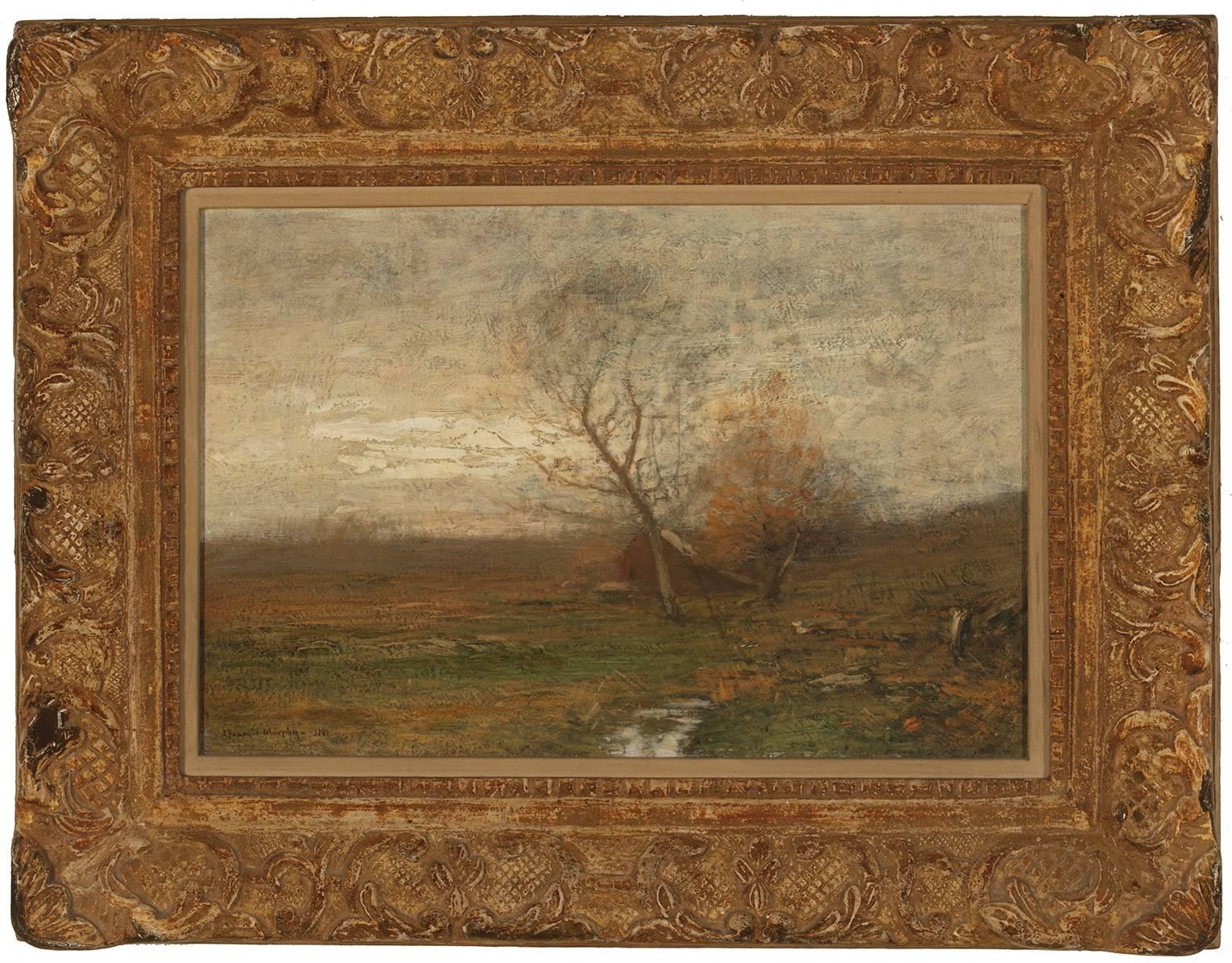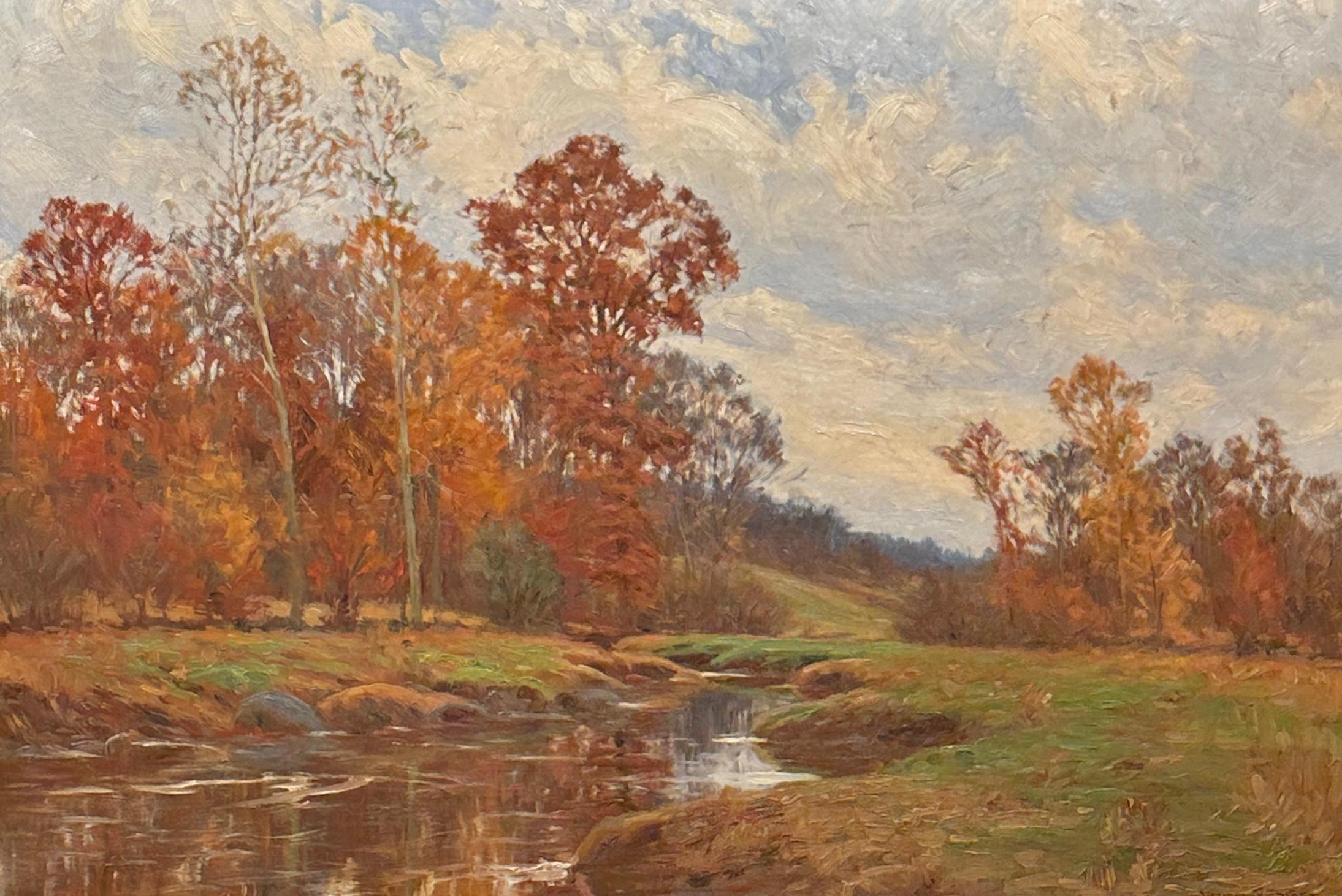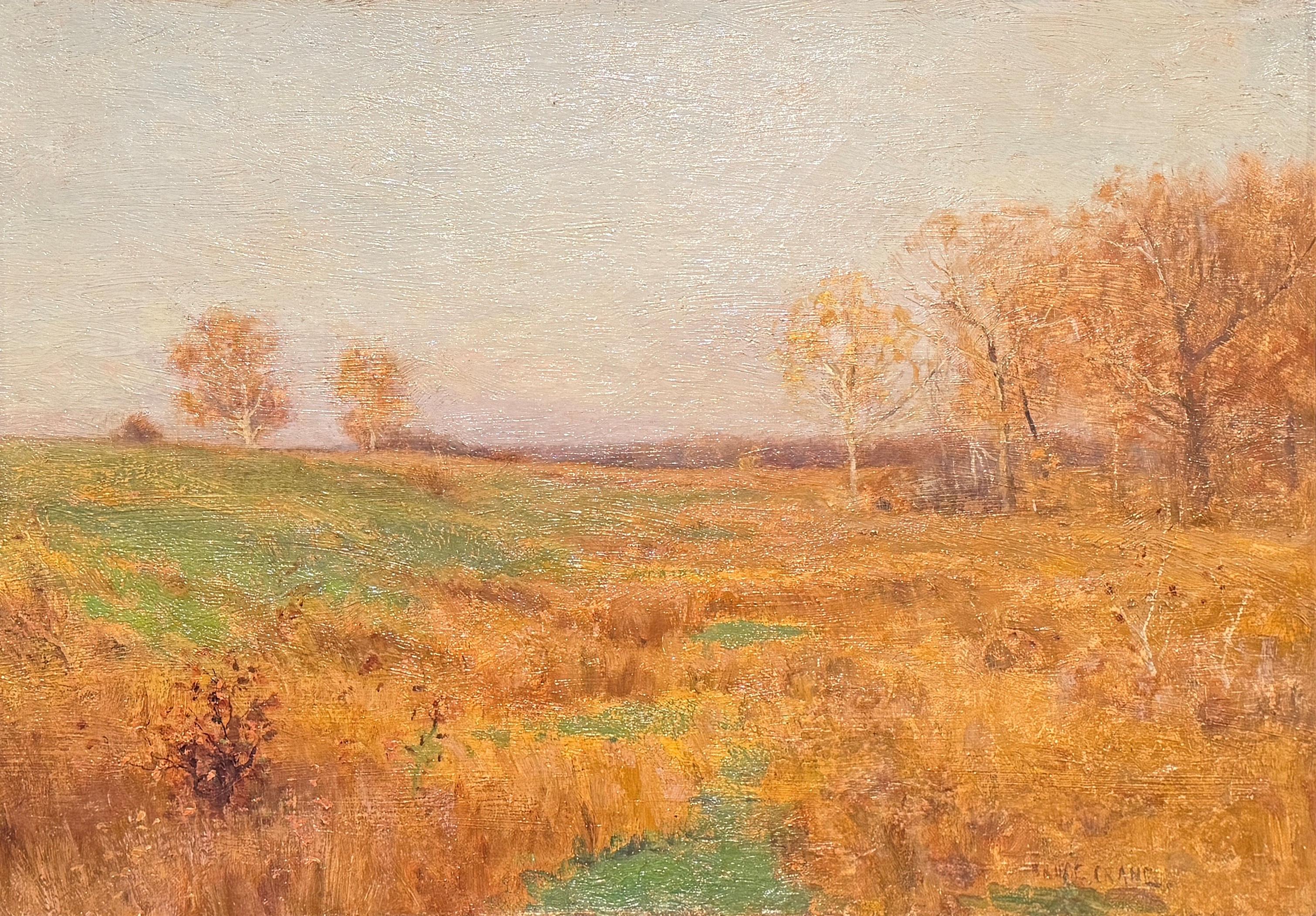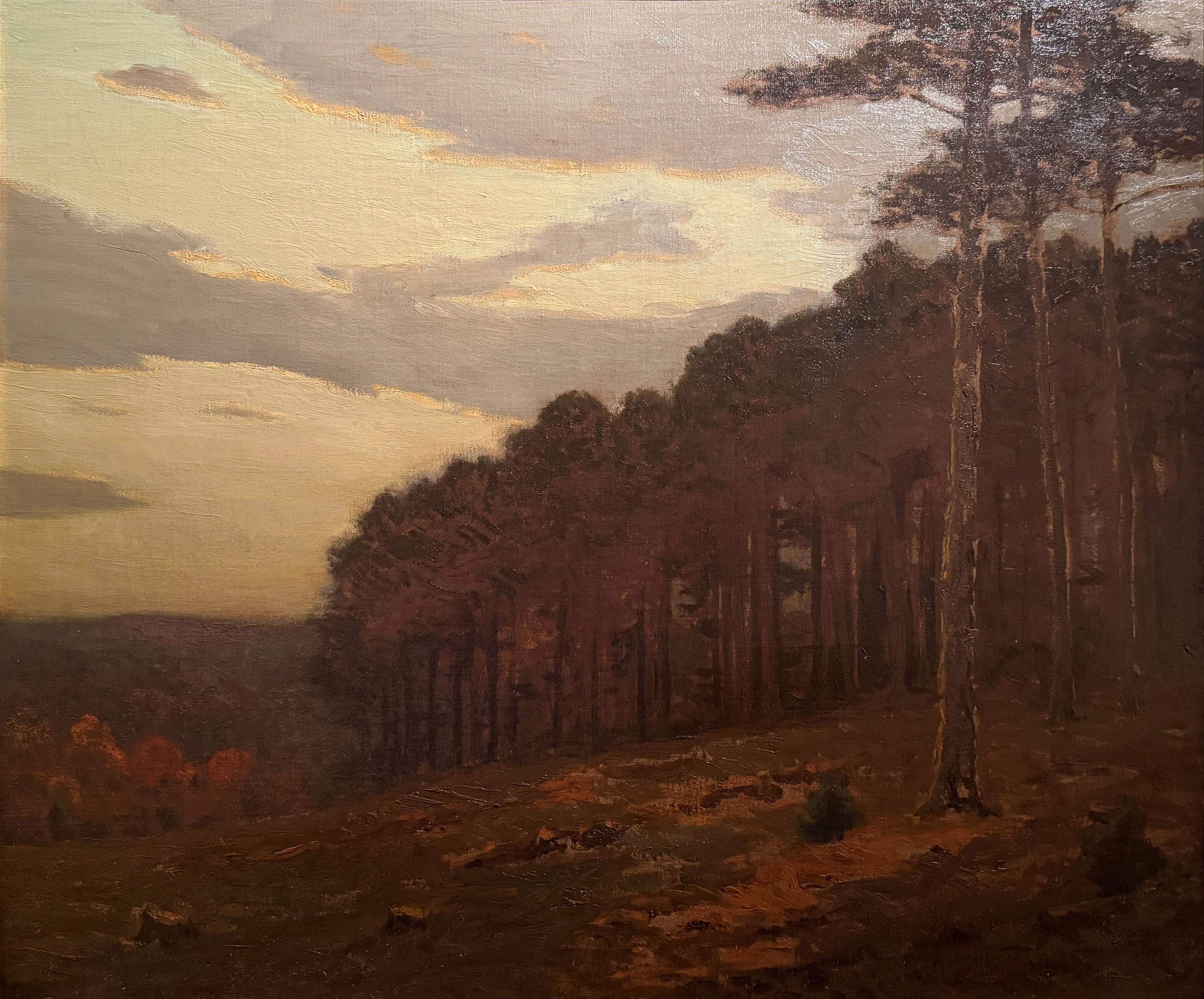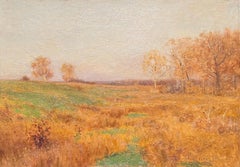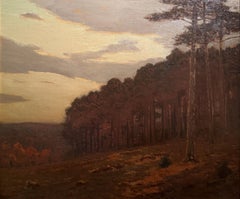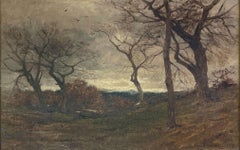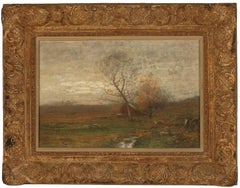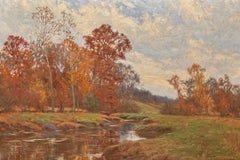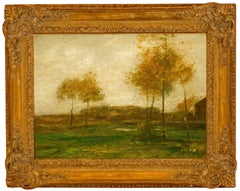Items Similar to "November" Bruce Crane, Tonalism Landscape Autumn Scene, American Impressionism
Want more images or videos?
Request additional images or videos from the seller
1 of 11
Bruce Crane"November" Bruce Crane, Tonalism Landscape Autumn Scene, American Impressionism
$15,000
£11,130.58
€12,965.60
CA$20,880.11
A$23,251.88
CHF 12,101.32
MX$286,692.93
NOK 154,119.58
SEK 144,857.46
DKK 96,739.48
Shipping
Retrieving quote...The 1stDibs Promise:
Authenticity Guarantee,
Money-Back Guarantee,
24-Hour Cancellation
About the Item
Bruce Crane (1857 - 1937)
November
Oil on canvas
25 x 30 inches
Signed lower right
Robert Bruce Crane was an American painter. He joined the Lyme Art Colony in the early 1900s. His most active period, though, came after 1920, when for more than a decade he did oil sketches of woods, meadows, and hills. He developed into a Tonalist painter under the influence of Jean-Charles Cazin at Grez-sur-Loing. Crane's mature works were nearly always fall and winter scenes. He usually painted in his studio in Bronxville, New York, where like many of the Tonalists he relied mostly on memories of his outdoor sketching experiences. Selected work can be found at the Florence Griswold Museum and the Newark Museum. He is a descendant of the Continental Congressman Stephen Crane.[1]
Bruce Crane's father, Solomon Crane, was an amateur artist himself and interested his son in the New York art scene from a young age. However, it was a summer trip to the Adirondacks that piqued Bruce's interest in painting after witnessing “a lot of young lady amateur (artists.)” At the age of seventeen around 1874 he moved with his family to Elizabeth, New Jersey where he worked as a draftsman for an architect. In hopes of starting a career in this field, he approached the famous artist Alexander Wyant and asked to start an apprenticeship with him. Wyant asked to see some of Crane's work, but Bruce did not believe that his skills were adequate enough to impress Wyant. Therefore, he declined the request and spent the next year improving his skills before he showed his work to Wyant and began to work with him. They remained friends until Wyant's death.
Bruce Crane began to then study at New York's Arts Student League and in 1876 he was featured for the first time in an exhibit at the National Academy of Design, submitting his painting called "Old Swedish Church, Philadelphia." Crane soon began to paint locations of East Hampton and Long Island, which brought him praise and critical approval, as well as a steady income.
In 1909 he won a bronze medal at the Carnegie Institute exhibition for his work November Hills, showing that he was still a force to be reckoned with. Throughout the first two decades of the 20th century, Crane won at least 10 major national and international awards. This included the Inness Gold Medal (1901), Gold metal at the St. Louis Exposition (1904), The Saltus Medal (1912), and the silver medal at the Panama-Pacific Exhibition (1915). From 1929 to 1933, Bruce Crane was the President of the famed Salmagundi Club of New York City (founded 1871) and its artist of the year in 1902. He was also associated with the Grand Central Art Galleries, participating in its 1933 members' drawing. In 1897, he was elected into the National Academy of Design as an Associate Academician, and became a full Academician in 1901.
- Creator:Bruce Crane (1857-1937, American)
- Dimensions:Height: 34 in (86.36 cm)Width: 39 in (99.06 cm)
- Medium:
- Movement & Style:
- Period:
- Condition:
- Gallery Location:New York, NY
- Reference Number:1stDibs: LU1841210527522
Bruce Crane
Robert Bruce Crane was an American painter. He joined the Lyme Art Colony in the early 1900s. His most active period, though, came after 1920, when for more than a decade he did oil sketches of woods, meadows, and hills. He developed into a Tonalist painter under the influence of Jean-Charles Cazin at Grez-sur-Loing. Crane's mature works were nearly always fall and winter scenes. He usually painted in his studio in Bronxville, New York, where like many of the Tonalists he relied mostly on memories of his outdoor sketching experiences. Selected work can be found at the Florence Griswold Museum and the Newark Museum. He is a descendant of the Continental Congressman Stephen Crane.[1] Bruce Crane's father, Solomon Crane, was an amateur artist himself and interested his son in the New York art scene from a young age. However, it was a summer trip to the Adirondacks that piqued Bruce's interest in painting after witnessing “a lot of young lady amateur (artists.)” At the age of seventeen around 1874 he moved with his family to Elizabeth, New Jersey where he worked as a draftsman for an architect. In hopes of starting a career in this field, he approached the famous artist Alexander Wyant and asked to start an apprenticeship with him. Wyant asked to see some of Crane's work, but Bruce did not believe that his skills were adequate enough to impress Wyant. Therefore, he declined the request and spent the next year improving his skills before he showed his work to Wyant and began to work with him. They remained friends until Wyant's death. Bruce Crane began to then study at New York's Arts Student League and in 1876 he was featured for the first time in an exhibit at the National Academy of Design, submitting his painting called "Old Swedish Church, Philadelphia." Crane soon began to paint locations of East Hampton and Long Island, which brought him praise and critical approval, as well as a steady income. In 1909 he won a bronze medal at the Carnegie Institute exhibition for his work November Hills, showing that he was still a force to be reckoned with. Throughout the first two decades of the 20th century, Crane won at least 10 major national and international awards. This included the Inness Gold Medal (1901), Gold metal at the St. Louis Exposition (1904), The Saltus Medal (1912), and the silver medal at the Panama-Pacific Exhibition (1915). From 1929 to 1933, Bruce Crane was the President of the famed Salmagundi Club of New York City (founded 1871) and its artist of the year in 1902. He was also associated with the Grand Central Art Galleries, participating in its 1933 members' drawing. In 1897, he was elected into the National Academy of Design as an Associate Academician, and became a full Academician in 1901.
About the Seller
5.0
Platinum Seller
Premium sellers with a 4.7+ rating and 24-hour response times
Established in 2022
1stDibs seller since 2022
108 sales on 1stDibs
Typical response time: <1 hour
- ShippingRetrieving quote...Shipping from: New York, NY
- Return Policy
Authenticity Guarantee
In the unlikely event there’s an issue with an item’s authenticity, contact us within 1 year for a full refund. DetailsMoney-Back Guarantee
If your item is not as described, is damaged in transit, or does not arrive, contact us within 7 days for a full refund. Details24-Hour Cancellation
You have a 24-hour grace period in which to reconsider your purchase, with no questions asked.Vetted Professional Sellers
Our world-class sellers must adhere to strict standards for service and quality, maintaining the integrity of our listings.Price-Match Guarantee
If you find that a seller listed the same item for a lower price elsewhere, we’ll match it.Trusted Global Delivery
Our best-in-class carrier network provides specialized shipping options worldwide, including custom delivery.More From This Seller
View All"Autumn Landscape, " Bruce Crane, Tonalist American Impressionist Fall Scene
By Bruce Crane
Located in New York, NY
Bruce Crane (1857 - 1937)
Autumn Landscape
Oil on canvas
25 x 30 inches
Signed lower right
Robert Bruce Crane was an American painter. He joined the Lyme Art Colony in the early 190...
Category
Early 20th Century Tonalist Landscape Paintings
Materials
Canvas, Oil
"Autumn Landscape" Bruce Crane, Bright Orange, Luminous, Tonalist Fall Scene
By Bruce Crane
Located in New York, NY
Bruce Crane
Autumn Landscape
Signed lower right
Oil on canvas
16 x 24 inches
Bruce Crane Was born in New York City, he studied with Alexander H. Wyant before attending the Art Stud...
Category
1910s American Impressionist Figurative Paintings
Materials
Canvas, Oil
"Autumn, New England" Charles Warren Eaton, Tonalist Gloaming Sunset in Woods
By Charles Warren Eaton
Located in New York, NY
Charles Warren Eaton
Autumn, New England
Signed lower right
Oil on canvas
30 x 36 inches
Provenance
Private Collection, Connecticut
A contemporary critic wrote that the paintings o...
Category
Early 1900s Tonalist Figurative Paintings
Materials
Canvas, Oil
"Stone Wall, Autumn, " George Smillie, Tonalist Fall Landscape View
By George Henry Smillie
Located in New York, NY
George Henry Smillie (1840 - 1921)
Stone Wall, Autumn, 1879
Oil on canvas
9 1/2 x 15 inches
Signed and dated lower right
Provenance:
Skinner, Boston, September 19, 2014, Lot 389
The career of George Smillie (1840-1921) followed the arc of nineteenth-century U.S. landscape painting. Trained in the Hudson River School tradition, Smillie successfully adapted to changing U.S. tastes and growing interest in European trends. In the late 1800s, he moved to tonalist paintings full of brushwork and influenced by French Barbizon painting. By the end of his career, he had lightened his palette to produce works similar to those of the U.S. impressionists. Yet in all styles, he was never less than competent, and his tonalist work is among the best produced in the United States.
Like many nineteenth-century painters, George Smillie’s artistic training began with the study of printing. His father, James Smillie...
Category
1870s Tonalist Landscape Paintings
Materials
Canvas, Oil
"Farmland Meadows" George Henry Smillie, Hudson River School, Sunset Landscape
By George Henry Smillie
Located in New York, NY
George Henry Smillie
Farmland Meadows, 1865
Signed and dated lower left
Oil on canvas
10 1/2 x 18 inches
Provenance
Private Collection, Langley, Washington
The career of George Sm...
Category
1860s Tonalist Figurative Paintings
Materials
Canvas, Oil
"A Cloudy Day, " View of Montclair, New Jersey, Tonalist, Barbizon Scene
By George Inness
Located in New York, NY
George Inness (1825 - 1894)
A Cloudy Day, 1886
Oil on canvas
25 x 30 inches
Signed and dated lower center
Provenance:
The artist
Estate of the above
Fifth Avenue Galleries, New York, Executor's Sale of Paintings by the Late George Inness, N.A., February 12 - 14, 1895, Lot 132
Joseph H. Spafford, acquired from the above
Mrs. Spafford, by bequest from the above
Leroy Ireland, New York, 1951
Ernest Closuit, Fort Worth, Texas
Meredith Long & Company, Houston, Texas, circa 1960
Private Collection
Shannon's Fine Art, American and European Fine Art Auction, October 27, 2016, Lot 42
Exhibited:
New York, American Fine Arts Society, Exhibition of the Paintings Left by the Late George Inness, December 27, 1894, no. 90.
Literature:
LeRoy Ireland, The Works of George Inness: An Illustrated Catalogue Raisonne, Austin, Texas, 1965, p. 336, no. 1324, illustrated.
Michael Quick, "George Inness: A Catalogue Raisonne," Vol. II, New Brunswick, New Jersey, 2007, pp. 282-83, 311, no. 966, illustrated.
George Inness, one of America's foremost landscape painters of the late nineteenth century, was born in 1825 near Newburgh, New York. He spent most of his childhood in Newark, New Jersey. He was apprenticed to an engraving firm until 1843, when he studied art in New York with Regis Gignoux, a landscape painter from whom he learned the classical styles and techniques of the Old Masters. In 1851, sponsored by a patron, Inness made a fifteen-month trip to Italy. In 1853 he traveled to France, where he discovered Barbizon landscape painting, leading him to adopt a style that used looser, sketchier brushwork and more open compositions, emphasizing the expressive qualities of nature.
After working in New York from 1854 to 1859, he moved to Medfield, Massachusetts, and four years later to New Jersey, where through a fellow painter he began to experiment with using glazes that would allow him to fill his compositions with subtle effects of light. Duncan Phillips remarked on Inness’s mellow light as a unifying force, saying, “…he was equipped to modernize the grand manner of Claude and to apply the methods of Barbizon to American subjects."
At this time also, Inness developed an interest in the religious theories of Emanuel Swedenborg...
Category
1880s Hudson River School Landscape Paintings
Materials
Canvas, Paint, Oil
You May Also Like
"Fall Landscape"
By John Francis Murphy
Located in Lambertville, NJ
Jim’s of Lambertville is proud to offer this artwork by:
John Francis Murphy (1853 - 1921)
John Francis Murphy is increasingly recognized today as one of the leading American Tonal...
Category
Early 1900s Tonalist Landscape Paintings
Materials
Canvas, Oil
Autumn, 1923
By Bruce Crane
Located in Milford, NH
A splendid Autumn tonalist landscape by American artist Bruce (Robert Bruce) Crane (1857-1937). Crane was born in New York City, and as an artist, was influenced by the French Barbizon school of...
Category
1920s Tonalist Landscape Paintings
Materials
Canvas, Oil
Accomplished Tonalist Painter William Merritt Post New England Landscape
By William Merritt Post
Located in Rockport, MA
William Merritt Post (1856–1935) was an American tonalist and landscape painter celebrated for his atmospheric depictions of rural New England. Working in a tonal style, Post used mu...
Category
20th Century American Impressionist Landscape Paintings
Materials
Oil
"The Low Lands"
By John Francis Murphy
Located in Lambertville, NJ
Jim’s of Lambertville is proud to offer this artwork.
Signed and Dated Lower Left
John Francis Murphy (1853 - 1921)
John Francis Murphy is increasingly recognized today as one o...
Category
Early 1900s Tonalist Landscape Paintings
Materials
Canvas, Oil
Dennis Sheehan, "Autumn Afternoon", 18x30 Dusk Landscape Oil Painting
By Dennis Sheehan
Located in Saratoga Springs, NY
This piece, "Autumn Afternoon", by artist Dennis Sheehan is a 18x30 oil painting on canvas featuring a landscape at dusk. Remaining light from the...
Category
2010s Tonalist Landscape Paintings
Materials
Canvas, Oil
Autumn on Canal, American Impressionist Landscape, Oil on Board, Signed
By Albert Van Nesse Greene
Located in Doylestown, PA
"Autumn on Canal" is a Pennsylvania landscape by American Impressionist painter Albert Van Nesse Greene.
The painting is a 8" x 10" oil on board, framed, and signed "A V Greene...
Category
Early 20th Century American Impressionist Landscape Paintings
Materials
Oil, Board
